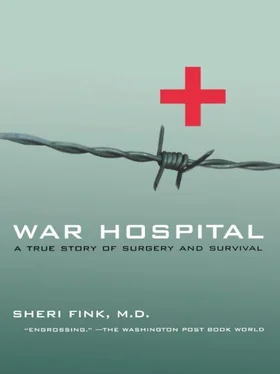Notes
PAGES 261–262 It is not a major offensive. Report of the Secretary-General Pursuant to General Assembly Resolution 53/35 (1998), “UN Srebrenica Report,” Section 225.
CHAPTER 25: “OUR SINCEREST APOLOGIES”
Note
A great deal is now known about the attack on the Srebrenica enclave and the responses of Dutch U.N. forces. In addition to interviews, this account relies heavily on two secondary sources, both of which are based on original communications of the Dutch forces: the U.N. Srebrenica Report and the 7,600-page NIOD report. The excellent accounts by Chuck Sudetic ( Blood and Vengeance) and David Rohde ( Endgame) were also extremely valuable, as was the text of the ICTY judgment against General Krstić. I doublechecked these secondary sources against primary source material from MSF (frequent satellite telex reports sent by Christina Schmitz at MSF Srebrenica to MSF Belgrade headquarters) and interviews with those on the ground, including one Dutch soldier, Dr. Gerry Kremer, who, having been relieved of his medical duties by his surgeon replacement a few days before the attack on Srebrenica, spent much of his time with Dutch officers and on the rooftop of the Dutchbat compound viewing the offensive. I’ve done my best to reconcile conflicting accounts and have noted any important outstanding questions in footnotes.
Interviews
Dr. Fatima Klempić-Dautbašić, Dr. Gerry Kremer, Dr. Daniel O’Brien, Dr. Ilijaz Pilav, Naim Salkić, Pierre Salignon, Nijaz Salkić, Christina Schmitz
Published Literature
Holbrooke, To End a War, p. 64–65 (Janvier’s secret hostage negotiations with Mladic and the subsequent change in UN air power approval policy), Rohde, Endgame, p. 11; “NIOD report:” III/5/12 (advance indicators of the attack); III/6/5 (Serb attacks on July 6); IV/4 (explains that the UNMO team had dropped from six to three when, during a rotation on June 24, Serbs had refused entry to the replacements); III/6/5 and III/6/6 (events on sixth, also discusses tacit pledge of Dutchbat to Srebrenicans that they would resist a Serb attack and who knew and didn’t know about this promise); III/6/4 (explanation of the detailed application procedure required for Close Air Support); III/6/24 (Ramiz Bečirović); III/6/8 (denial of Bečirović’s request for arms held by UNPROFOR); III/6/6 (events of the seventh); III/6/7 (events of the eighth including the killing of a Dutchbat soldier, Van Renssen, and failure to transmit air power request); III/6/8 (July 9 including flight of Swedish shelter project residents, Karadžić decision to authorize capture of Srebrenica, Srebrenica War President Osman Suljić’s letter to Bosnian President Izetbegović); III/6/9 (Srebrenicans’ inability to use “Red Arrow” missiles); III/6/13 (July 10 discord between U.S. and Russian Federation in Security Council, debate over calling in a NATO air strike, failure to decide on a resolution, declaration by Security Council chairman calling on the parties to respect the safe area).
Kremer, “Medical neutrality in crisis control areas,” Medisch Contact, #45, November 8, 1996, reviews Dutchbat’s refusals to provide medical care to the local population
Documents
Report of the Secretary-General Pursuant to General Assembly Resolution 53/35 (1998), “UN Srebrenica Report” : Section 480 (asserts that the attack on the OPs warranted the use of Close Air Support “even in the most restrictive interpretation of the mandate”); Section 249 (Karremans’ July 7 “appeal on behalf of the population”); 250–251 (attacks on morning of the eighth); 252–254 (afternoon of the eighth and takeover of OP-Foxtrot)
Srebrenica hospital anesthesia records: details of surgery performed on the schoolteacher; records from July 6–11 have some gaps (e.g., no records for July 8 and 9) and appear possibly incomplete; the low number of surgeries represented is inconsistent with recollections of the doctors and nurses involved. They say they were too busy to document all of their work. It is also possible that some of these records were taken or destroyed before I found them in Srebrenica Hospital in 1999.
Unpublished internal MSF reports: situation report from Christina June 26, 1995 (“How come we accept their weapons… ”); Christina’s final situation report covering July 6–22, 1995 (describes being awoken by the shelling on the July 6, agreement to end MSF’s strike on July 9); telex MSF Sreb to Belgrade (hereafter “Bg”) July 6 10:35 (indicators of the attack); telex MSF Sreb to Bg July 7 12:23:27 (Dutchbat refusal to give blood or treat patients, comment “they could at least take some patients”); telex MSF Bg to Sreb July 9 11:49 (“I am sure they will help”); weekly MSF Srebrenica report ending July 7 (“new, more distanced involvement”); telex UN B Company to MSF Sreb July 7 02:11:45 (requests casualty information); telex MSF Sreb to MSF Bg July 8 11:19:59 (casualties opposite Dutchbat compound, July 7’s casualties, Ilijaz close to breakdown); telex July 8 [no time on my copy] MSF Sreb to Bg (Christina hears more than one shell a minute); telex July 9 [no time] MSF Sreb to Bg (“quite tense and shocked”); telex July 9 MSF Sreb to Bg “News from 10:30AM” (Christina requests soldiers and weapons be kept out of hospital complex); telex July 10 MSF Sreb to Bg, 7:00AM (events in hospital overnight July 9–10 confirming Ilijaz worked all night); telex July 10 Dutchbat to MSF Sreb, 12:16 UTC describes the APCs coming under tank and mortar fire whenever the APCs attempt to move south; telex July 10 UTC Dutchbat logs offers Perspex windows to MSF.
Krstić judgment relates Karadžić’s decision to authorize the capture of Srebrenica.
Notes
PAGE 265 “Say hello to Ibrahim.” This combines information from two sources, which may or may not be describing the same event: The U.N. Srebrenica Report (Section 238) says the “Say Hello to Ibrahim” message was conveyed by an “international humanitarian worker” who saw military preparations, including heavy weapons and tanks, along the Bosnian Serb side of the Drina River on July 4 from near Zvornik down to Bratunac. The NIOD report (III/5/12) describes a similar event, that a U.N. interpreter said on July 5 that a “large column of armoured and mechanized units were moving from the direction of Zvornik to Bratunac… A passing UNHCR convoy only noticed these transports by coincidence.”
PAGE 266 It also reassured her… Karremans was not interviewed. His quote was recalled by Christina Schmitz. His assertion in June that the Bosnian army could hold its positions is also unverified. It is taken from the NIOD Report (section III/5/12) based on the recollections of the commander of the British Joint Commission Observers that Karremans had made this statement to an MSF doctor in June.
PAGE 267 Throughout the morning… The figure comes from a satellite telex message sent from MSF Belgrade to MSF Srebrenica citing information from U.N. military observers based on reports from the observation posts. NIOD III/6/5 says the Bosnian Second Corps in Tuzla reported to UNPROFOR Sector North East that a thousand projectiles hit the city over the day.
PAGE 267 The Serbs fire on positions of Srebrenica soldiers… NIOD III/6/6.
PAGE 267 The Serbs also lob shells into civilian areas… According to capsat 7/7/95, 12:23:27 from MSF Srebrenica to MSF Belgrade.
PAGE 268 Around 1 P.M…. Rohde, Endgame, p. 11, reports the 1 P.M. attack on the defense wall and the “UN Srebrenica Report” describes the 1:20 P.M. hit to the watchtower. Sudetic, Blood and Vengeance, reports a hit to the watchtower, p. 267. These might all have been the same event.
Читать дальше












